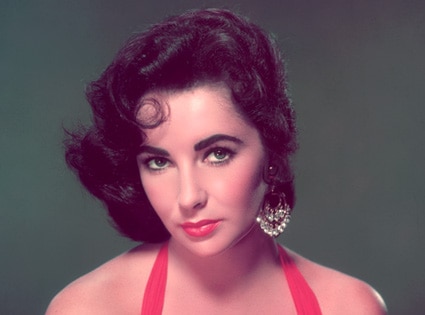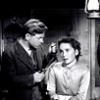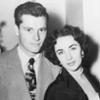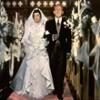 Hulton Archive/Getty Images
Hulton Archive/Getty Images Elizabeth Taylor, who died today at age 79, didn't dwell on death—as she used to say, she'd already been there, done that.
"I'm a survivor," she once said, "a living example of what people can go through and survive."
Was she ever.
LOOK BACK: 2011's other fallen stars
Nine Lives
In the beginning, in the 1940s, Taylor was a child star of uncommon beauty who won hearts in Lassie Come Home and National Velvet. In her prime, in the 1950s and 1960s, she was an A-list star who commanded the screen opposite Paul Newman (Cat on Hot Tin Roof), James Dean and Rock Hudson (Giant), and drew Hollywood's first $1 million payday. In later years, she was a bawdy, grand dame who didn't shirk her past, or make excuses for her excesses.
"When I was 15, I told [MGM studio chief] L.B. Mayer to go to hell," Taylor said in The Advocate in 1996. "It was then that I realized I was a complete, free individual and that I loved God…And I felt free."
True to her spirit, if not her sense of the dramatic, Taylor was the first actor to be pronounced dead—and go on to win two Academy Awards.
No, the great Elizabeth—she detested her media nickname, Liz—didn't do anything small.
"The more, the better, has always been my motto," she said in 1994.
Beginnings
Born Elizabeth Rosamond Taylor on Feb. 27, 1932, in London to American parents, the girl for whom the phrase "violet-eyed beauty" would become synonymous arrived in Hollywood in 1939 as her family fled war-torn Europe. A neighbor secured Taylor a screen test with Universal Pictures. She was put under contract, and at age 10, debuted in the 1942 comedy, There's One Born Every Minute.
If Taylor's screen presence was evident early on, Universal didn't see it—the studio cut her loose. And so it was MGM that would secure the services of the future icon.
Her first feature for Mayer's star factory was the Technicolor canine classic, 1943's Lassie Come Home, costarring Roddy McDowall, a fellow child actor who became one of Taylor's fiercest real-life friends.
Her next major role, in 1944's National Velvet, proved her breakthrough—and her medical downfall.
During filming of the equestrian drama, the 12-year-old Taylor took a spill from a horse. The resulting back injury proved chronic—the first in a terribly long list of ailments, which included: an emergency tracheotomy (a byproduct of near-fatal double pneumonia) (1961); severe respiratory problems (1990); double hip replacement surgery (1995); an irregular heartbeat (1996); a benign brain tumor (1997); a broken back (1998); a second broken back (1999); pneumonia (2000); skin cancer (2002); a broken foot (2003); heart surgery (2009); and congestive heart failure dating back to the early 2000s. The health troubles helped fuel dependencies on alcohol and painkillers, which landed the legend twice in rehab, in 1983 and 1988.
During the double pneumonia spell, which resulted in Taylor being administered last rites, the actress said she "actually saw the light."
"When I came to, there were about 11 people in the room. I'd been gone for about five minutes—they had given me up for dead and put my death notice on the wall," Taylor told The Advocate.
Taylor's habit of holing up in the hospital was rivaled only by her habit of walking down the aisle.
LIFE IN PICTURES: Remembering Elizabeth Taylor, 1932-2011
Marriages and Divorces
In what's now known as corporate synergy, but then was just good old-fashioned publicity, MGM launched production of Father of the Bride in tandem with the announcement that Taylor, at age 17, was engaged to one William Pawley Jr.
The Taylor-Pawley nuptials were never to be, superceded by the Taylor-Hilton nuptials. Hilton was Nicholas Conrad Hilton Jr., the hotel scion and future great uncle of Paris and namesake Nicky Hilton. He was also the first ex-Mr. Taylor.
The Taylor-Hilton union endured less than nine months, with reports of Hilton's alleged abusiveness to surface years later.
A divorcee at not-quite 19, Taylor became a mother at not-quite 21, with the birth of a son to her second husband, actor Michael Wilding.
The Taylor-Wilding union produced one more son before ending in 1957.
Proving that the 1950s must have been more a tad more permissive than public-health films of the era let on, the moviegoing public never disowned its "violet-eyed beauty," even if by mid-decade, she was a two-time divorcee. Taylor, in fact, enjoyed her greatest cinematic run, highlighted by four successive Oscar nominations, from 1958-1961, as she embarked on her third and fourth marriages.
In 1957, the 24-year-old Taylor wed producer/impresario Mike Todd. The marriage produced a daughter, born prematurely in August 1957, but lasted only 13 months. The culprit wasn't divorce; it was a plane crash that claimed Todd's life. (As noted by People, Taylor's own passing came nearly 53 years to the day of the March 22, 1958, accident.)
Following Todd's death, public sympathy for Taylor was at an all-time high.
Enter Eddie Fisher.
Scandal
In 1958, Fisher was a chart-topping singer, a TV star, and a picture-perfect husband to girl-next-door Debbie Reynolds. Fisher and Reynolds were good friends of Todd and Taylor. When Todd died, Fisher lent Taylor a hand. And then some.
"The thought of having a love affair with Elizabeth never entered my mind. Never," Fisher wrote in his autobiography. "But at about 4 a.m. [one] night…she called me. I don't remember much of our conversation, except she said emphatically, 'When you get back, we have to talk. I want to see you.' I assumed she wanted to talk about Mike. Which demonstrates how little I understand women."
And thus commenced the Taylor-Fisher affair, which begat the Reynolds-Fisher divorce, which, in 1959, begat the Taylor-Fisher marriage.
While the scandal cooled the career of Fisher, who died in 2010, it helped his new bride score a groundbreaking movie deal.
In October 1959, Taylor, notorious as a home-wrecking sexpot, agreed to star as the empire-wrecking sexpot of Cleopatra for $1 million, the first time any Hollywood star—male or female—hit the seven-figure mark.
In the beginning, Taylor's salary amounted to one-half of Cleopatra's budget. In the end, it didn't amount to one-fortieth.
Cleopatra was, in two words, a mess. The production schedule was plundered by bad weather. Sets were built, taken down and rebuilt. A director quit. Costars bailed. The script never quite got done. Pneumonia nearly killed the leading lady.
By April 1961, Taylor, at least, was back on track, having risen from her deathbed to accept her Oscar, her first, for the call-girl drama Butterfield 8. (Remarked Shirley MacLaine, nominated that year for The Apartment: "I thought I might win...until Elizabeth Taylor had her tracheotomy.")
Meanwhile, back at Cleopatra: Richard Burton, then in-demand as the star of Broadway's Camelot, was brought in to play Marc Antony, Taylor's onscreen lover. In time, he became Taylor's offscreen lover, too. And thus commenced the Taylor-Burton affair, which begat Burton's divorce from his wife, which begat Taylor's divorce from Fisher, which, in 1964, begat Taylor's marriage to Burton.
"What do you expect me to do?" Taylor asked once. "Sleep alone?"
Meanwhile, back at Cleopatra: The movie finally got made. It bowed in theaters in 1963, won four Oscars and grossed a then-strong $26 million. One problem: It cost its studio a then-staggering $44 million—the equivalent of a $300 million-plus production today.
What marriages, divorces and scandal could not do, Cleopatra did: The movie put a drag on Taylor's career.
RELATED: Mourning Elizabeth Taylor—Hollywood Greats React to Death of Hollywood's Greatest
Transitions
After Cleopatra, Taylor never again starred in anything approaching an epic or box-office blockbuster. In just her early 30s, she became the world's most famous character actress, taking on offbeat films, such as John Huston's Reflections of a Golden Eye, and rejecting glamour for dowdiness, as in Who's Afraid of Virginia Woolf?, for which she won her second Best Actress Oscar.
Taylor's new career was Burton. The star couple costarred in eight films, including Virginia Woolf, and one TV-movie. Most of the projects were bad or worse. With movies such as Boom! to their discredit, Taylor and Burton proved themselves the anti-Tracy and Hepburn.
At least the couple appeared to be enjoying themselves. They adopted a daughter in 1964, and stayed together long enough for Taylor to celebrate her first, and only, 10-year wedding anniversary. But not long after the milestone, the Taylor-Burton union ended. It was briefly revived for Taylor-Burton II, from 1975-76.
By the 1970s, Taylor's film career was all but over. During her 1976-82 marriage to U.S. Sen. John Warner, her seventh husband, Taylor's weight ballooned, and she became a comic target for the likes of John Belushi and Joan Rivers.
Eventually, the laughter died; Taylor lived on. She did stint on General Hospital, at the height of the soap's Luke-and-Laura popularity. She did Broadway, even reuniting there with Burton. In 1985, as friend Hudson was dying of AIDS, she led Hollywood efforts to battle the disease, cofounding the American Foundation for AIDS Research, and later, establishing the Elizabeth Taylor AIDS Foundation and the Elizabeth Taylor Endowment Fund. She launched her own line of perfume. She even got married—again.
During a 1988 rehab stay at the Betty Ford Center, Taylor met Larry Fortensky, a fellow patient and mullet-maned construction worker 20 years her junior. It was a match made for a paparazzi-pleasing 1991 wedding at Michael Jackson's Neverland Ranch. Said Taylor at the time: "I always said I would get married one more time and with God's blessings, this is it, forever."
Forever lasted about five years. Taylor and Fortensky separated in 1995, with the divorce finalized in 1997.
Burton, whom Taylor called, along with Todd, "one of the two great loves of my life," died in 1984, at age 58.
In later years, about the closest Taylor came to the altar was when she stood up for Liza Minnelli at the singer's own ill-fated 2002 wedding to producer David Gest. (Appropriately, Jackson was present for those nuptials, too.)
Taylor's last film appearance came in 1994's The Flintstones.
The Dame
If Taylor's career waned in the later years, then her early years were enough to ensure a wealth of career honors—from the American Film Institute, the Kennedy Center, the Motion Picture Academy, and even the Queen of England, who deigned Taylor a Dame of the British Empire in 2000.
In 2003, Taylor announced her retirement. Public appearances became rare. When she did venture out, she was often in a wheelchair. In 2006, Australian and U.K. tabs said Taylor was "at death's door." Her publicist labeled the reports false. A month later, the National Enquirer said Taylor was in the early stages of Alzheimer's disease. This time, Taylor herself labeled the report false.
"Oh, come on, do I look like I'm dying?" Taylor asked Larry King in 2006, her first TV interview in years. "Do I look like or sound like I have Alzheimer's?"
Ever the survivor, Taylor outlived the author of her New York Times obituary by nearly six years.
Though retired from Hollywood, Taylor refused to retire from her activist work. "There's still so much more to do," she told the Associated Press in 2005. "I can't sit back and be complacent, and none of us should be. I get around now in a wheelchair, but I get around."
Yes, Taylor did manage to get around.
As she herself once admitted: "My life has had so many ups and downs that sometimes it takes even my breath away."
Sphere: Related Content
![Validate my Atom 1.0 feed [Valid Atom 1.0]](valid-atom.png)





























































Nenhum comentário:
Postar um comentário